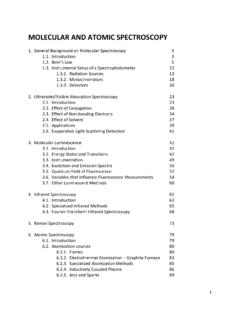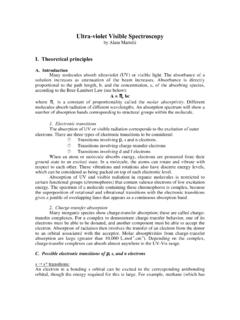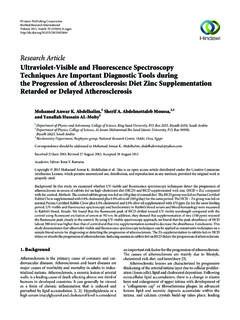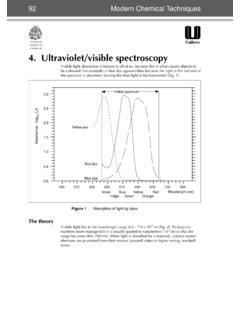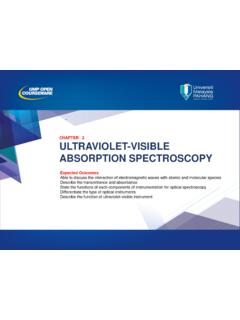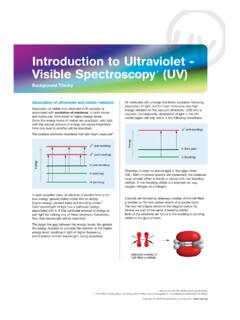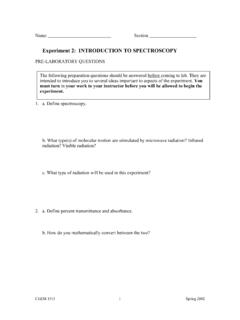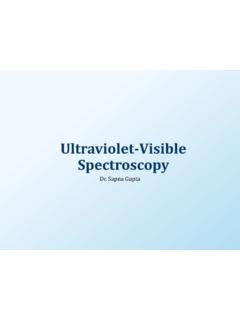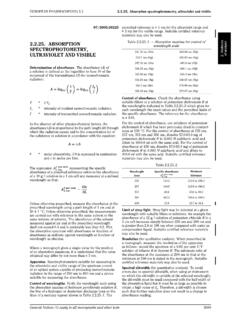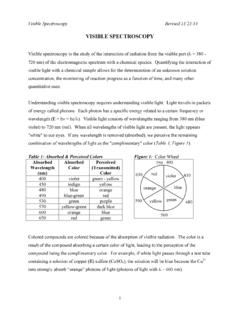Transcription of Optical properties of secondary organic aerosols using ...
1 imholt 1 Optical properties of secondary organic aerosols using ultraviolet / visible spectroscopy felisha imholt imholt 2 I. ABSTRACT It is well known that the increased warming effect due to greenhouse gases is a major environmental concern. While the amount of solar radiation absorbed by greenhouse gases is known to a high certainty, the amount absorbed by secondary organic aerosols (SOA) is not. Our study aimed to discover how much radiation SOA particles absorb between ~200 and 800 nm. The SOA were created in one of two temperature controlled Teflon chambers within Dr. John Shilling s lab at PNNL and were collected on 47 mm Teflon filters. We used an ultraviolet - visible (UV/Vis) spectrometer equipped with a liquid waveguide capillary flow cell to determine the amount of radiation SOA absorbs at various wavelengths.
2 We developed and optimized UV/Vis procedures for SOA dissolved in three solvent systems: water, methanol, and M hydrochloric acid. We also successfully determined the mass absorption coefficient values and imaginary refractive indices for the generated SOA. These values will be used in climate models developed at PNNL. imholt 3 II. INTRODUCTION Much uncertainty surrounds the impact of tropospheric aerosols on the enhanced greenhouse effect. aerosols can affect the Earth s energy balance through direct and indirect radiative effects (Bluvshtein, Flores, Riziq, & Rudich, 2012). Currently, the amount of light absorbed and scattered by aerosols is uncertain. This is of high importance in current atmospheric research because of the impact light absorption can play on the atmosphere.
3 Absorption by aerosols could raise the atmospheric temperature by absorbing light and radiating it back into the atmosphere in the form of heat. (Alexander, Crozier, & Anderson, 2008). These aerosols are created from both human and natural sources. A large fraction of anthropogenic aerosol mass comes from fossil fuel and biomass burning in the form of carbonaceous particles. Carbonaceous aerosols also come from natural biogenic emissions (Alexander, Crozier, & Anderson, 2008). Biogenic emissions result from the combustion or decomposition of biologically-based materials that are not fossil fuels. When these semi-volatile organics oxidize, the resulting condensed phase particles are termed secondary organic aerosols (SOA) (Kroll & Seinfeld, 2008). An increase in the emission of both anthropogenic and biogenic emissions would produce more SOA (Alexander, Crozier, & Anderson, 2008).
4 Once formed, SOA can undergo physical and chemical changes in the atmosphere such as coagulation, structural rearrangement, and phase transition (Fuzzi et al., 2006). Several factors influence SOA formation including reactions in the presence of acid catalysts, relative humidity, and concentration of organics and oxidants (Kroll & Seinfeld, 2008). Some scientists suggest that 91% of SOA are caused by O3 and OH oxidation (Chung & Seinfeld, 2002). Others propose that ozonolysis dominates SOA production compared to OH imholt 4 and NOx oxidation (Kanakidou et al., 2005). organic material, which composes SOA, was previously thought to scatter light. However, SOA could be a type of light-absorbing carbon. Light-absorbing carbon (LAC) includes both black carbon (BC) and brown carbon (BrC) (Lambe et al.)
5 , 2013). The Optical properties of BC are known to absorb radiation at wavelengths above ~500 nm. BrC has been documented to absorb light at wavelengths lower than that of BC, at ~300 to 500 nm. This BrC has a different nature than black carbon (Alexander, Crozier, & Anderson, 2008). SOA absorbs light radiation between ~300 and 500 nm which indicates that it could be a form of BrC (Alexander, Crozier, & Anderson, 2008). Although SOA has been shown to absorb light, the amount absorbed is still unclear and is the topic of our research. Our research aimed to study SOA Optical properties . By measuring the light absorbed by SOA, we calculated the mass absorption coefficient (MAC) value and imaginary refractive indexes (k values). These values will be used in climate models developed at PNNL. Our study will help to improve climate models and increase the understanding of SOA.
6 III. EXPERIMENTAL A. Validation of UV/Vis Technique using a 100-cm liquid waveguide capillary flow cell (LWCC) and an ultraviolet / visible spectrometer (UV/Vis), we determined the amount of ~250-700 nm range light radiation absorbed by SOA. The UV/Vis had been used in the lab once prior to our experiment for the same purpose. We refined the previously developed technique here. The equipment was validated using Suwannee River fulvic acid (FA). Ghabbour and Davies (2009) as well as Lambe et al. (2007) have studied and described the MAC and k values characteristic of FA. By imholt 5 using FA and comparing their MAC values with ours, we can determine the validity of the refined UV/Vis procedure. Three solvents were used: water, methanol, and hydrochloric acid (HCl). Methanol was used as a second solvent in order to elucidate the effect of a different solvent on SOA.
7 The third solvent, M HCl, was chosen because of an experiment done to characterize the peroxide content in SOA. This study required the use of M HCl as a solvent. The HCl was created by mixing 50 mL HCl and 200 mL ultrapure Milli-Q water (Millipore ultrapure water system, Milli-Q Advantage A10). In order to create the calibration curves for the water, methanol, and M HCl solvent systems, stock solutions were created with FA. The FA/water stock solution was used to dilute FA to solutions of various concentrations in both water and HCl. Another FA stock solution was made for the methanol experiment. The concentrations of the two stock solutions are shown in Table 1. Dilute solutions were created between the concentrations of mg/L and mg/L at increasing intervals of mg/L. The solution concentrations were approximately , , , , and mg/L.
8 The solutions were then put into 10-mL glass syringes and injected into the 100-cm path length LWCC (World Precision Instruments model LWCC-3100). The absorbance of light (205-700 nm) generated using a miniature deuterium-tungsten halogen light Table 1. Stock solutions in two solvents: water and methanol (MeOH). Amount FA Amount solvent Final Concentration g g water 120 mg/L FA in Water g g MeOH 110 mg/L FA in MeOH imholt 6 source (Ocean Optics Inc. model DT-MINI-2-GS) was measured using a UV/Vis spectrometer (Ocean Optics, Inc. Jaz model UX-83500-20). B. Generation of SOA Particles The SOA particles used in the experiment were produced in one of two m3 Teflon reaction chambers (Xu et al., 2014). Each chamber consists of a 10 x 5 x 7 Teflon reaction bag enclosed in a single temperature controlled room (15-45 oC).
9 Each chamber can be operated independently in either a continuous flow mode or in the traditional batch mode (Shilling et al., 2009). Light is provided constantly by 110 UVA-340 fluorescent lamps which surround the chamber. Volatile organic compounds (VOC) were added to the chamber by injecting the VOC into a glass bulb with a syringe and then gently heating it. The vapors were then transported into the chamber via a flow of purified air. To initiate the SOA formation, a variety of oxidants were used including OH. OH is created by photolysis of either H2O2 or HONO (depending on whether experiments were run under high-NOx or low-NOx conditions). Additional NO is occasionally injected from a pre-mixed gas cylinder to further control the NOx concentrations, which determines the fate of generated organic peroxy radicals.
10 Analysis of the particle and gas phases was recorded in real time using a variety of analytical instrumentation including an Aerodyne HR-ToF-AMS, an Ionicon PTR-MS, and a TSI SMPS. After generation, the SOA samples were collected on 47-mm Teflon filters with collection times ranging from 2 to 6 hours. The filters were cut in half with a razor blade and the SOA was extracted from the filter via ultrasonication in 10-mL of methanol, water, or M HCl. Each side of the filter was sonicated for 5 minutes. Raw data from the Scanning Mobility Particle Sizer (SMPS) gave the volume of particles per volume of sample collected (#/cm3 and imholt 7 nm3/cm3). using this data, calculated the concentration of SOA particles on the filter in mg/L. The absorbance of the resulting SOA solution was measured using the above outlined UV/Vis procedure used for the FA solutions.
